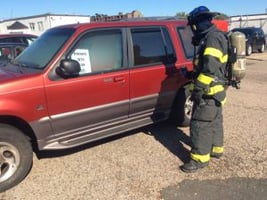By Dr. Christina Baxter, Emergency Response TIPS, LLC Posted on December 4, 2017
#1 Implement Risk Based Response Procedures and Training
There is no one way to respond to a synthetic opioid incident. The level of response should match the level of risk. For example, some synthetic opioid incidents can be managed by EMS or law enforcement patrol personnel with only nitrile gloves. Other synthetic opioid incidents require a specialized response team with chemical protective clothing, SCBA, and a decontamination set-up.
Responders should be trained to conduct a risk assessment and determine the appropriate level of response based upon the identified risk. To prepare personnel to make risk-based response decisions, your response team should put together a guideline and training program to clearly identify which level of response is required based on the perceived level of risk.
To assist agencies, Federal Resources offers our DrugIQ: Synthetic Opioids Risk-Based Response course. This 8-hour course provides responders training on how to conduct a risk assessment for a synthetic opioid scene. Students learn to look for incident indicators, or “clues”, that can be used to categorize the incident into one of four levels of risk. Each student receives four laminated field guides with considerations for PPE, response, and decontamination as well as the resources required for each level of risk.
DrugIQ is 50% hand- on. In the afternoon, students operate three types of synthetic opioid clan labs, perform electrostatic decon, and use multiple detection technologies on challenging samples, including trace and bulk samples, cutting agents,, street-cut material, and pure material.
Agencies that build their own guideline and training program are encouraged to utilize the guidance in the Inter-Agency Board (IAB) recommendations found here.
To learn more about DrugIQ, or if you’d like to host a DrugIQ course at your agency, contact us at training@julianneg3.sg-host.com.
#2 Ensure your PPE Meets the Right Standard
Personal protective clothing selected for synthetic opioid incidents should be based on the risk assessment. For all levels of risk, Nitrile gloves used should meet the NFPA 1999 standard.
Ensure the chemical protective clothing your team plans on wearing at a synthetic opioid incident meets the NFPA 1994 or NFPA 1999 standard.
Level B suits that meet the NFPA 1992, Standard on Liquid Splash-Protective Ensembles and Clothing for Hazardous Materials Emergencies, are not intended for protection against powders such as synthetic opioids. As stated in the standard, they are designed for “protection against adverse liquid-splash environments”.
If you have questions about PPE selection for synthetic opioids, contact us at training@julianneg3.sg-host.com.
#3 Ensure your Detectors are up to Date
There are a variety of detectors on the market capable of detecting synthetic opioids. Having the technology on your hazmat truck is not enough. You need to ensure it is up-to-date. Many vendors of FTIR, Raman, and mass spectrometry-based detectors have released updated software and libraries for synthetic opioids and cutting agents. Make sure you have downloaded and installed the updates. A recent software update for the MX908 includes a new Drug Hunter Mode designed for field detection of illicit drugs, including synthetic opioids.
To receive library and firmware updates, most manufacturers require your instrument be covered by a warranty service or reach-back service. If you need to add warranty to reachback to any instrument, contact Federal Resources: sales@julianneg3.sg-host.com.
#4 Enhance your Decon Capabilities
Synthetic opioids such as carfentanil, are extremely toxic. Even a small amount of cross-contamination can be fatal. Dry decon alone presents a high risk of cross-contamination as the synthetic opioid particles tend to become airborne. Wet decon alone simply moves the synthetic opioid into a pool of synthetic opioid solution, that can still be hazardous. Consider adding a military decon solution, such as the Navy’s Dahlgren Decon, to render safe the synthetic opioids.
Synthetic opioid powders are extremely lightweight and can be blown over 10 feet by traditional decon sprayers. Electrostatic decon sprayers apply the decon solution in a gentle mist to reduce spreading the contamination. In addition, electrostatic sprayers impart a charge on the decon solution improve coverage with electrostatic wrapping. Click here to read an article from our September newsletter to learn more about how electrostatic wrapping improves decon.
More information about Dahlgren Decon solution for synthetic opioid decon is available here.
#5 Conduct a joint Hazmat / Law Enforcement Meeting
Hazmat and law enforcement agencies should meet and discuss capabilities between public safety hazmat teams and law enforcement clandestine lab teams. Team leaders should have a working relationship with the DEA Clandestine Lab Coordinator (CLC) in their region. It’s important that hazmat and law enforcement coordinate public safety sampling and evidence preservation procedures.
Local crime labs are great sources of information on exact synthetic opioids that are being seized in your area. Responders should be aware of crime lab backlogs, and triage protocols required to expedite sample testing, such as responder exposures.
Remember, to safely execute an operational response to an event involving synthetic opioids, you should: First, conduct a risk assessment; next, ensure that the response is commensurate with the level of risk including the selection of PPE, detection, and decontamination equipment; and, coordinate your response with law enforcement and hazmat teams and appropriate.
